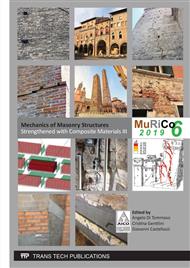[1]
S. De Santis, G. de Felice, Tensile behaviour of mortar-based composites for externally bonded reinforcement systems, Compos Part B 68 (2015) 401-413.
DOI: 10.1016/j.compositesb.2014.09.011
Google Scholar
[2]
G. de Felice, S. De Santis, L. Garmendia, B. Ghiassi, P. Larrinaga, P.B. Lourenco, D.V. Oliveira, F. Paolacci, C.G. Papanicolaou, Mortar-based systems for externally bonded strengthening of masonry, Mater Struct 47(12) (2014) 2021-2037.
DOI: 10.1617/s11527-014-0360-1
Google Scholar
[3]
A. Bellini, B. Ferracuti, C. Mazzotti, Effect of matrix on bond between FRCM and masonry, Proc. of FRPRCS-12/APFIS-2015 Joint Conference, Nanjing, China, 14-16 December (2015).
Google Scholar
[4]
F.G. Carozzi, A. Bellini, T. D'Antino, G. de Felice, F. Focacci, L. Hojdys, L. Laghi, E. Lanoye, F. Micelli, M. Panizza, C. Poggi, Experimental investigation of tensile and bond properties of Carbon-FRCM composites for strengthening masonry elements, Compos Part B 128 (2017) 100-119.
DOI: 10.1016/j.compositesb.2017.06.018
Google Scholar
[5]
M. Leone, M.A. Aiello, A. Balsamo, F.G. Carozzi, F. Ceroni, M. Corradi, M. Gams, E. Garbin, N. Gattesco, P. Krajewski, C. Mazzotti, D. Oliveira, C. Papanicolaou, G. Ranocchiai, F. Roscini, D. Saenger, Glass fabric reinforced cementitious matrix: tensile properties and bond performance on masonry substrate, Compos Part B 127 (2017) 196-214.
DOI: 10.1016/j.compositesb.2017.06.028
Google Scholar
[6]
S. De Santis, F. Ceroni, G. de Felice, M. Fagone, B. Ghiassi, A. Kwiecień, G.P. Lignola, M. Morganti, M. Santandrea, M.R. Valluzzi, A. Viskovic, Round Robin Test on tensile and bond behavior of Steel Reinforced Grout systems, Compos Part B 127 (2017) 100-120.
DOI: 10.1016/j.compositesb.2017.03.052
Google Scholar
[7]
NTC 2008, D.M. 14 Gennaio 2008. Nuove Norme Tecniche per le costruzioni, Italian Ministry of Infrastructures and Transportation, Rome, (2008).
Google Scholar
[8]
H.W. Reinhardt, Fracture mechanics of an elastic softening material like concrete, Heron 29 (2), (1984).
Google Scholar
[9]
Determination of the fracture energy of mortar and concrete by means of three-point bend tests on notched beams, Mater Struct 18 (1985) 287-290.
DOI: 10.1007/bf02472918
Google Scholar
[10]
Z.P. Bazant, Mechanics of fracture and progressive cracking in concrete structures, in: G.C. Sih and A. Di Tommaso (Eds.), Fracture mechanics of concrete: structural application and numerical calculation, Martinus Nijhoff Publishers, 1985, pp.1-94.
DOI: 10.1007/978-94-009-6152-4_1
Google Scholar
[11]
K. Mosalam, L. Glascoe, J. Bernier, Mechanical Properties of Unreinforced Brick Masonry, United States, 2009,.
DOI: 10.2172/966219
Google Scholar
[12]
R. van der Pluijm, Non-linear behavior of masonry under tension, Heron 42(1),1977, pp.25-55.
Google Scholar
[13]
R. Hayen, K. Van Balen, D. Van Gemert, Triaxial interaction of natural stone, brick and mortar in masonry constructions, in: L. Schueremans (Eds.), Building Materials and Building technology to Preserve the Built Heritage, WTA Schriftenreihe, 2009, pp.333-352.
Google Scholar
[14]
UNI EN 1015-11. Methods of test for mortar for masonry – Part 11: Determination of flexural and compressive strength of hardened mortar. (2007).
DOI: 10.3403/01905442u
Google Scholar
[15]
EN 13412. Products and systems for the protection and repair of concrete structures. Test methods. Determination of modulus of elasticity in compression. (2006).
DOI: 10.3403/02593405
Google Scholar
[16]
A. Bellini, M. Bovo, C. Mazzotti, Experimental and numerical evaluation of fiber-matrix interface behaviour of different FRCM systems, Compos Part B 161 (2019) 411-426.
DOI: 10.1016/j.compositesb.2018.12.115
Google Scholar
[17]
A. Bellini, S. Kahangi Shahreza, C. Mazzotti, Cyclic bond behavior of FRCM composites applied on masonry substrate, Compos Part B 169 (2019) 189-199.
DOI: 10.1016/j.compositesb.2019.04.009
Google Scholar


